| Lot |
Photo |
Description |
Lot 292 |
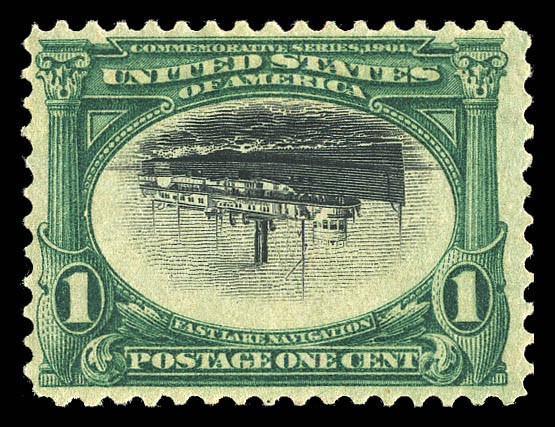 |

1901, 1¢ Pan-American, center inverted (294a), wonderfully bright and fresh and quite well centered for this; original gum, F.-V.F.
Scott $12,500
AN ATTRACTIVE, COMPLETELY SOUND MINT EXAMPLE OF THIS FAMOUS INVERT.
Expertization: 1989 PSE and 2006 PF Certificates.
Provenance: Little
The 1¢ Pan-American with its center inverted turned up at four different post offices across the country. It is widely believed that between 600 and 700 copies were sold.
View details and enlarged photo
|
Lot 293 |
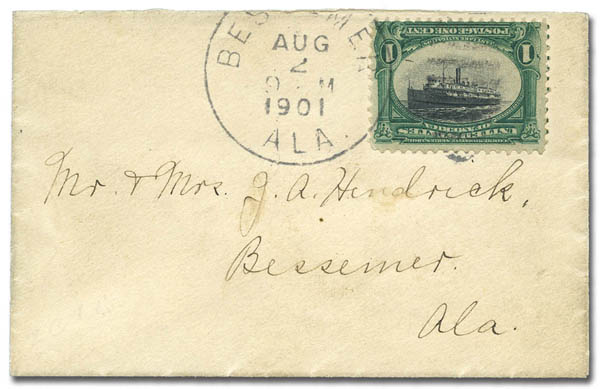 |

1901, 1¢ Pan-American, center inverted (294a), rich color, nicely centered, tied by neat strike of "Bessemer Ala. Aug 2 1901" duplex c.d.s. on small cover addressed to Mr. and Mrs. J. A. Hendrick in Bessemer; stamp with a tiny, completely unnoticeable repair at lower right, otherwise Very Fine.
Estimate 100,000 - 150,000
A WORLD CLASS INVERTED CENTER RARITY, THE EARLIEST OF ONLY THREE RECORDED COVERS BEARING THE ONE-CENT PAN-AMERICAN INVERT.
Expertization: 1999 PF Certificate.
Provenance: Seybold, Atwood, Weill Bros., Skinner, "Aristocrat"
Exhibited at the Collectors Club of New York as one of the ten most important items in U.S. Philately. The display was titled, "Aristocrats of Philately".
The three recorded covers are:
1. August 2, 1901, Bessemer, Alabama local use — The example offered here — Bessemer was where the initial discovery of the 1¢ Invert was made. Featured on the front cover of the "Aristocrat" Collection catalogue, Matthew Bennett International Sale 316, May 22, 2007.
2. August 24, 1901 Oakland, California to Paris, France bearing a 1¢ Invert and a normal 4¢ paying the 5¢ rate
3. January 9, 1903, St. Louis philatelic usage with normal 1¢ mailed long after the invert had been recognized.
According to the 1937 revised Johl-King book (p. 7), "The first known copies of this error were discovered at Bessemer, Alabama, by the Carrel Jewelry Company on some circulars just prior to mailing them. When they realized the find they had made they lost no time in removing the stamps from the circulars and thus saved them for Philately." It is not known if the Carrel Jewelry Company had purchased the entire sheet, or whether this stamp originates from another source within Bessemer.
View details and enlarged photo
|
Lot 294 |
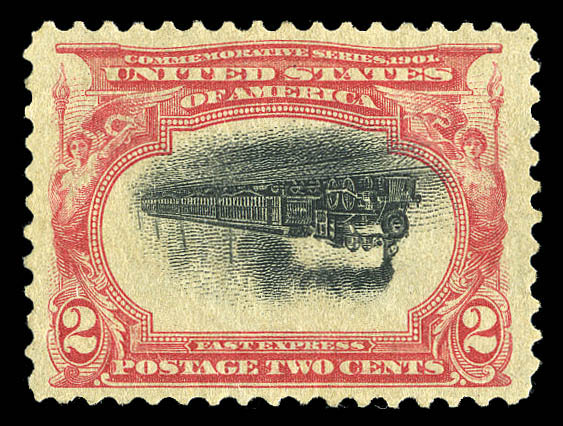 |

1901, 2¢ Pan-American, center inverted (295a), virtually perfectly centered amid remarkably large margins with strong color for this frequently pale invert; full original gum, tiny, virtually unnoticeable trace of a prior natural inclusion above left "2" (noted only on the 2006 certificate); fresh and choice, Extremely Fine.
Scott $55,000+
ONE OF THE BEST CENTERED EXAMPLES OF THIS RARE INVERT AND ONE OF THE FEW WITH FULL ORIGINAL GUM.
Expertization: 1964, 1989, 2000 & 2006 PF Certificates.
Provenance: Gorham
The 2¢ is the rarest of the regularly issued Pan-American Inverts with probably no more than 200 being issued. This supposition is based on the fact that two shades of the error exist, meaning that at least two panes of 100 were released; also upon the current estimate that approximately 150 examples have survived, including about a half dozen used singles and two mint blocks (one rejoined).
Scott also states that "almost all unused examples…have partial of disurbed gum" and values the stamp accordingly.
View details and enlarged photo
|
Lot 295 |
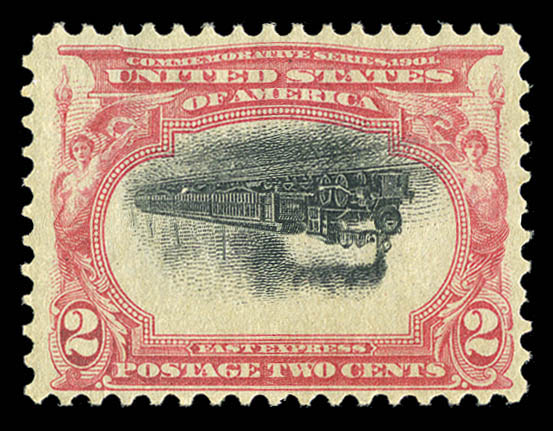 |

1901, 2¢ Pan-American, center inverted (295a), exceptionally well centered for a 2¢ invert with handsome color and full original gum, completely free of the defects that normally plague this issue, fresh and choice Very Fine.
Scott $55,000+
WITH ITS COMBINATION OF EXCELLENT CENTERING, FULL ORIGINAL GUM AND FAULT-FREE STATE OF PRESERVATION, THIS 2¢ PAN-AMERICAN INVERT IS AMONG THE FINEST AVAILABLE.
Expertization: 1995 PF Certificate.
Provenance: "Derby", Rubin, Berlin
The 2¢ is the rarest of the regularly issued Pan-American Inverts with probably no more than 200 being issued. This supposition is based on the fact that two shades of the error exist, meaning that at least two panes of 100 were released; also upon the current estimate that approximately 150 examples have survived, including about a half dozen used singles and two mint blocks (one rejoined).
Scott also states that "almost all unused examples…have partial of disurbed gum" and values the stamp accordingly.
View details and enlarged photo
|
Lot 296 |
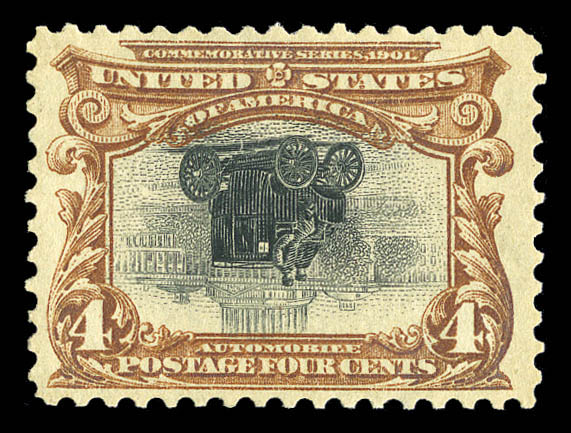 |

1901, 4¢ Pan-American, center inverted (296a), extraordinarily well centered for the 4¢ invert with exceptionally bright and fresh colors and full original gum, Extremely Fine and choice. SSV $750,000.
Scott $75,000+
AN EXCEEDINGLY RARE STAMP IN SOUND, WELL CENTERED CONDITION WITH FULL, UNDISTURBED ORIGINAL GUM, THIS IS, IN ALL LIKELIHOOD, THE FINEST 4¢ PAN-AMERICAN INVERT EXTANT. THERE IS ONLY ONE OTHER EXAMPLE GRADED XF 90 (BY PSE) AND THERE ARE NONE HIGHER.
Expertization: 2002 & 2012 PF Certificates, the latter graded XF 90.
Provenance: Drucker, Gorham
The 4¢ Pan-American invert, unlike the 1¢ and 2¢ was printed intentionally and was never intended for release to the public. While up to 100 examples were distributed unofficially, many of these were overprinted "Specimen". Another group of about 100 were later traded to philatelists for other stamps needed for the collection of the National Museum. This second group came from a sheet that had been stuck down to a backing sheet by the Post Office Department when they decided to make it part of their archives. This is why the large majority of non-Specimen overprints have disturbed gum. There are probably fewer than ten mint examples with the perforations clearing the design, that still maintain their full undisturbed original gum, making these examples the rarest of all the 20th century inverts in similar quality
The Scott Catalogue value for the 4¢ Invert, like that of the 2¢ is for "examples with full original gum that is slightly disturbed.
View details and enlarged photo
|
Lot 297 |
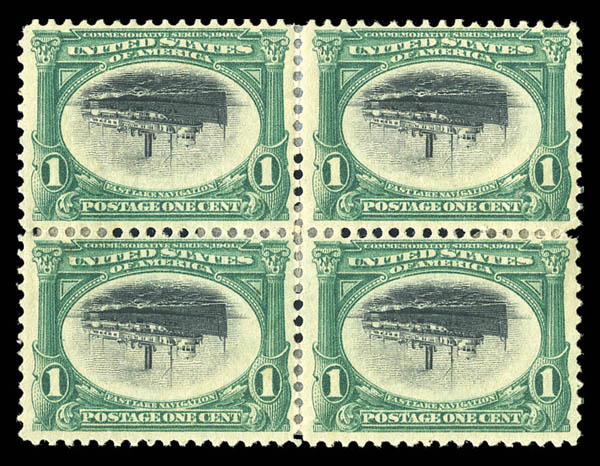 |
 
1901, 1¢ Pan-American, center inverted (294a), quite nicely centered with choice color, original gum, hinge remnants, some sensibly reinforced perf separation, small corner crease at upper right, fresh and otherwise F.-V.F.
Scott $75,000
A HANDSOME AND RARE BLOCK, OF WHICH ONLY ABOUT A DOZEN ARE BELIEVED TO EXIST.
Provenance: Col. Green, Zoellner
View details and enlarged photo
|
Lot 298 |
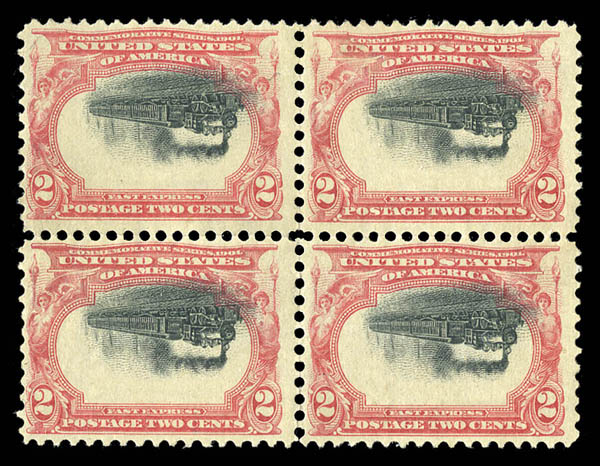 |
 
1901, 2¢ Pan-American, center inverted (295a), reconstructed block of four, nicely centered with full original gum showing traces of hinge removal, neatly rejoined along the perforations; F.-V.F.
Scott $220,000 as singles
Expertization: 1980 PF Certificate.
Provenance: Zoellner
The block was reassembled by the Weill Brothers of New Orleans after reacquiring the four singles from the heirs of a previous owner who had broken the block to give a single to each of his four children.
View details and enlarged photo
|
Lot 299 |
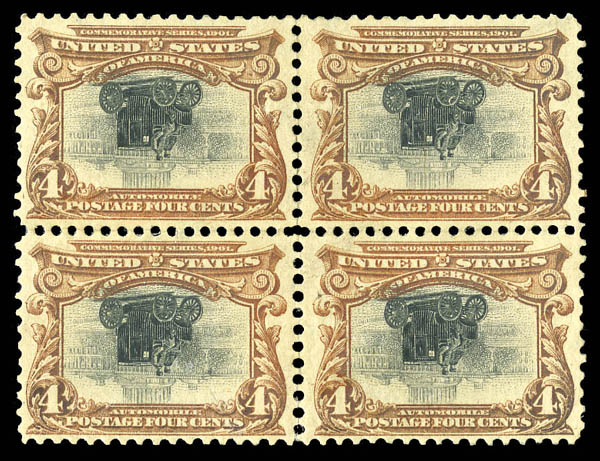 |
 
1901, 4¢ Pan-American, center inverted (296a), block of four, beautifully centered with rich color, slightly disturbed original gum, though much less so than normally found, some reinforced and rejoined perforations, small tear lower left stamp, otherwise Very Fine to Extremely Fine.
Scott $400,000
CERTAINLY ONE THE FINEST OF ONLY ABOUT A HALF DOZEN BLOCKS BELIEVED TO EXIST.
Expertization: photocopy of 1968 PF Certificate.
Provenance: Col. Green, Y. Souren, Lilly, Zoellner
The 4¢ Pan-American invert, unlike the 1¢ and 2¢ was printed intentionally and was never intended for release to the public. While up to 100 examples were distributed unofficially, many of these were overprinted "Specimen". Another group of about 100 were later traded to philatelists for other stamps needed for the collection of the National Museum. This second group came from a sheet that had been stuck down to a backing sheet by the Post Office Department when they decided to make it part of their archives. This is why the large majority of non-Specimen overprints have disturbed gum. There are probably fewer than ten mint examples with the perforations clearing the design, that still maintain their full undisturbed original gum, making these examples the rarest of all the 20th century inverts in similar quality
The Scott Catalogue value for the 4¢ Invert, like that of the 2¢ is for "examples with full original gum that is slightly disturbed.
View details and enlarged photo
|
Lot 300 |
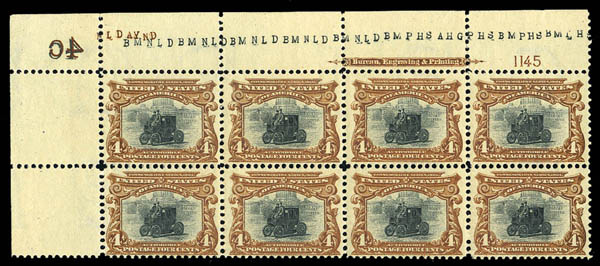 |
  
1901, 4¢ Pan-American (296), upper left corner imprint & plate no. block of eight with multiple pressmen's initials, quite well centered with rich color, solid perforations and immaculate, never hinged original gum; fresh and Very Fine.
Scott $3,860
Expertization: 2007 PSE Certificate.
View details and enlarged photo
|
Lot 301 |
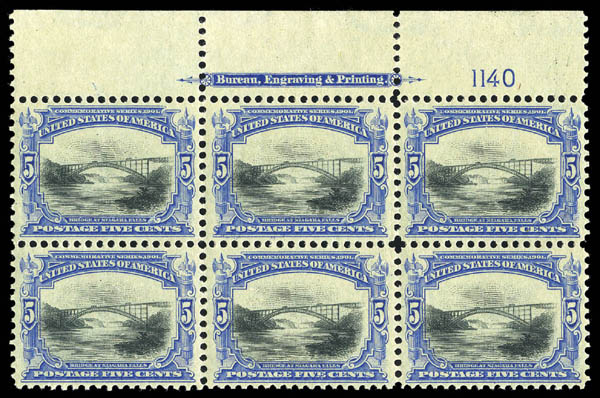 |
  
1901, 5¢ Pan-American (297), top margin imprint & plate no. block of six, virtually perfectly centered, bright and crisp with brilliant color and full, never hinged original gum; post office fresh and Extremely Fine to Superb.
Scott $3,750
AN EXTRAORDINARY PLATE BLOCK OF THE 5¢ PAN-AMERICAN—FRESH, FULLY INTACT AND VIRTUALLY IMPOSSIBLE TO IMPROVE UPON.
Expertization: 2008 PF Certificate.
View details and enlarged photo
|
Lot 302 |
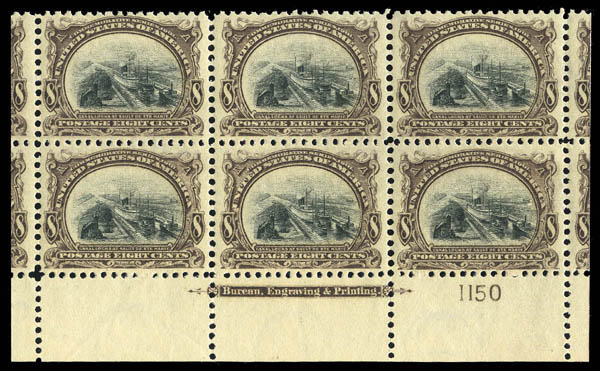 |
  
1901, 8¢ Pan-American (298), bottom margin imprint & plate no. block of six, outstanding centering, cut to include portions of adjoining stamps at the sides; exceptionally fresh with solid, intact perforations and post office fresh, never hinged original gum; Extremely Fine and choice.
Scott $6,250
8¢ PAN-AMERICAN PLATE BLOCKS IN THIS REMARKABLE QUALITY ARE FEW AND FAR BETWEEN.
Expertization: 2008 PF Certificate.
Provenance: Berlin
View details and enlarged photo
|
Lot 303 |
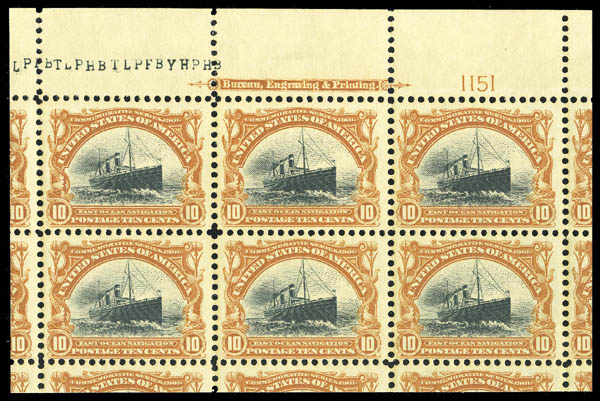 |
  
1901, 10¢ Pan-American (299), top margin imprint & plate no. block of six with multiple pressmen's initials, cut from the sheet so as to include portions of all nine surrounding stamps, exceptionally well centered with solid perforations, deep rich colors and never hinged original gum, Extremely Fine.
Scott $9,000
A STRIKING EXAMPLE OF A RARELY SEEN HIGH-GRADE PLATE BLOCK OF THE 10¢ PAN-AMERICAN.
Expertization: 2008 PF Certificate.
Provenance: Berlin
View details and enlarged photo
|
|